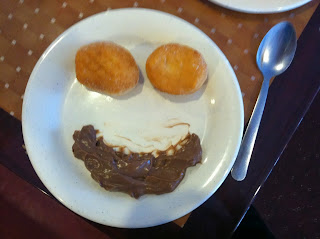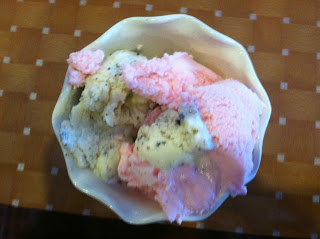Many of you are probably thinking, "Wait, what, Buffetimus Prime, he's back?" Well, much like Optimus was revived in Transformers: Revenge of the Fallen, your old Buffet Guru is back, and better than ever. Now, I've been humbled by the business of life, those of you that are any good at math know that it's been two years since my last post. That's bad form. That's like the buffet that let's the mac and cheese go cold. That's like the ice cream machine that doesn't mix properly and spits out inappropriate-looking white goo. But, last I checked, people are still eating at buffets, and last I check, the aforementioned buffets are still "All-you-can-eat". So once a week, I will be posting either a buffet field assignment, or another post related to the Art of Buffet, much like before. I figured, what better place to get the party started, than to do a strategic analysis of a Chinese Buffet.
Now, cat jokes aside, Chinese buffets are a good buffet experience. For one, they offer much more complex flavor profiles than your traditional American buffet. I can slam down chicken nuggets with the best of them, but Chinese food is based more in flavor profiling from sauces, such as the ever popular General Tsao's chicken or Kung Pao Chicken. (By the way, if anyone knows who General Tsao actuall was, please comment on this post. By the way his chicken tastes, he must've been a freakin' bad ass. By the way, you know how to spot a buffoob at the China Buffet? Look at the guy piling on slices of 'pizza' or quesadillas on his plate. Dude, go to the Pizza Hut buffet for that. You go to a Chinese Buffet, you eat Chinese food. I think I'll add that to the buffet commandments. Anyways, on to the analysis:

As you can see here, we have the traditional island set-up, the most common form of buffet placement for Chinese buffets. Hot foods in the middle three islands, and over to the right (not in the picture) you have your cold items. I recommend grabbing a plate (people need to know you mean business) and then make an S like pattern through the islands to scout out the buffet. Some things to consider: are there any trays that were just replaced? Those are go-to items--hot and fresh. Also, where are the big ticket items. Are there crab legs? These are usually the highest priced items at a Chinese buffets. Hit them early, and hit them often.
Also, the hot items and cold items are separate from each other for a reason, don't have both on the same plate. A common mistake that will lead to ridicule from your friends. Hot items go TOGETHER. For my first plate:
Plate One: "Dam Rice"
A couple of observations here, many of which you buffeteers have probably already noticed. I can hear it now, "OMG WTF Buffet King, why did you put rice on your first plate?! Don't you know that rice and carbs fill you up faster than any other buffet food. What a buffoob!" Here's what I have to say to you text-talking teenager. What is the purpose for the rice? If you look to the south region of the plate, what do you see? That's right, sweet and sour chicken. Now let me ask you this? Do you WANT sweet and sour chicken and broccoli? Do you WANT sweet and sour Mongolian beef? If you answer yes, than I've got nothing and that's just weird. As you can see, I've created a 'dam' of rice on my plate. The reason is twofold, one, and most obviously, it keeps the sweet and sour sauce from contaminating food that you don't want to be sweet and sour. The second reason is that rice is a great absorber of flavor. It will take on the flavor of whatever sauce surrounds it. Let me tell you folks, sweet and sour rice is really good! I'll admit, I could've made the dam smaller, as rice does indeed fill you up at the buffet. However, that is much lesser offense than letting sweet and sour sauce run all over your well-thought out plate. A couple other things to mention with this plate, if you look in the northwest and northeast quadrants of the plate (Mongolian beef and chicken and broccoli, respectively), there's something very important going on there. Something I like to call the M to V ratio. M to V stands for the "Meat to Vegetable". Ideally, you want this to be one to one. It always sucks having that one piece of broccoli at the end to not pair with chicken. And let's face it, that piece of broccoli probably feels left out as well. So unfortunately for the picture, the broccoli is hiding under the chicken, but I can assure you the B to C ratio there is one to one. Top it off with some salt and pepper chicken due north and you've got a pretty damn good first plate.
Plate Two: "Getting Saucy"
Despite the suggestive nature of the name of the plate, no, I did not go to the back room with one of the employees for a special treat. The main theme of this plate is sauce compatibility. "But wait, buffet king", you say, "You JUST talked about how sweet and sour sauce can ruin a good plate, and now you are talking about sauce compatibility?" That's right, ambiguous random guy that keeps asking questions. Here's the thing: does a brown sauce (like chicken and broccoli, relatively mild) and sweet and sour sauce (sweet and tangy) go together? If you have half a pallet, you know that the answer is "no". However, here in the upper left corner, there are some boneless spare ribs. Immediately right of those, honey chicken. Both tangy bases, sweet. Sauce compatibility? A match made in buffet heaven! Below in the southeast, some Garlic Chicken...to its left, Mongolian Beef (I was a fan). The garlic sauce on the beef was a great fit! Now, I'm not going to tell you what is right and what is wrong (even though I literally did that five lines up). This is about experimenting. A lot of people, when they load up their plate, just go for mass, forgetting that there is always a layer of sauce at the bottom. Find a sauce you like? Try pouring it over another item (such as a dumpling, which is the white thing in the middle of the plate) Take risks, you will never improve your buffeting skills if you don't. If you find any particularly amazing sauce combos, please let me know.
Plate Three: "Happy Ending"
Again, not doing myself a service with these names, I'm just trying to be punny. If I wanted an actual happy ending, I'd go for a sundae at Friendly's. So the final plate here, obviously dessert, is a no-brainer. Anyone that hasn't tasted a Chinese donut either A) hasn't lived, or B) has a severe allergic reaction to gluten. They are LITERALLY fried balls of dough, covered in sugar. If I could marry a Chinese buffet item, this would be it. Why throw on chocolate pudding? Didn't I just say don't mix hot and cold? Well, once you eat a good amount of that pudding, these Chinese donuts are perfect for sopping up anything leftover on the plate. Again, we are going for A) Plate optimization and B) Plate completion. This was the perfect dessert. And of course, you can never forget to top off your meal with:
A cup of ice cream. As the old saying goes, "There's always room for ice cream." Which is scientifically true, as the ice cream melts and fills up any remaining cracks in your stomach. And that, my buffeteers, is how a Chinese buffet is done. A few more points, Below pictured is my water glass:
What do you notice? Yeah! It's practically full. Pretty amateur stuff here, but you can always notice the buffoob that's slugging back water...he's just making himself full faster. A note on this: you may want to save spicy items towards the end of your meal. Obviously, really spicy items cause us to want to drink more water, which in turn is just making less room for other things. Other option? Drink soda!
Here, a highly ambiguous fortune cookie to finish off the meal. Much like the North Star has it place in the sky (love grammar in fortune cookies), buffets have a place in our stomach.
You stay classy, Buffeteers.





